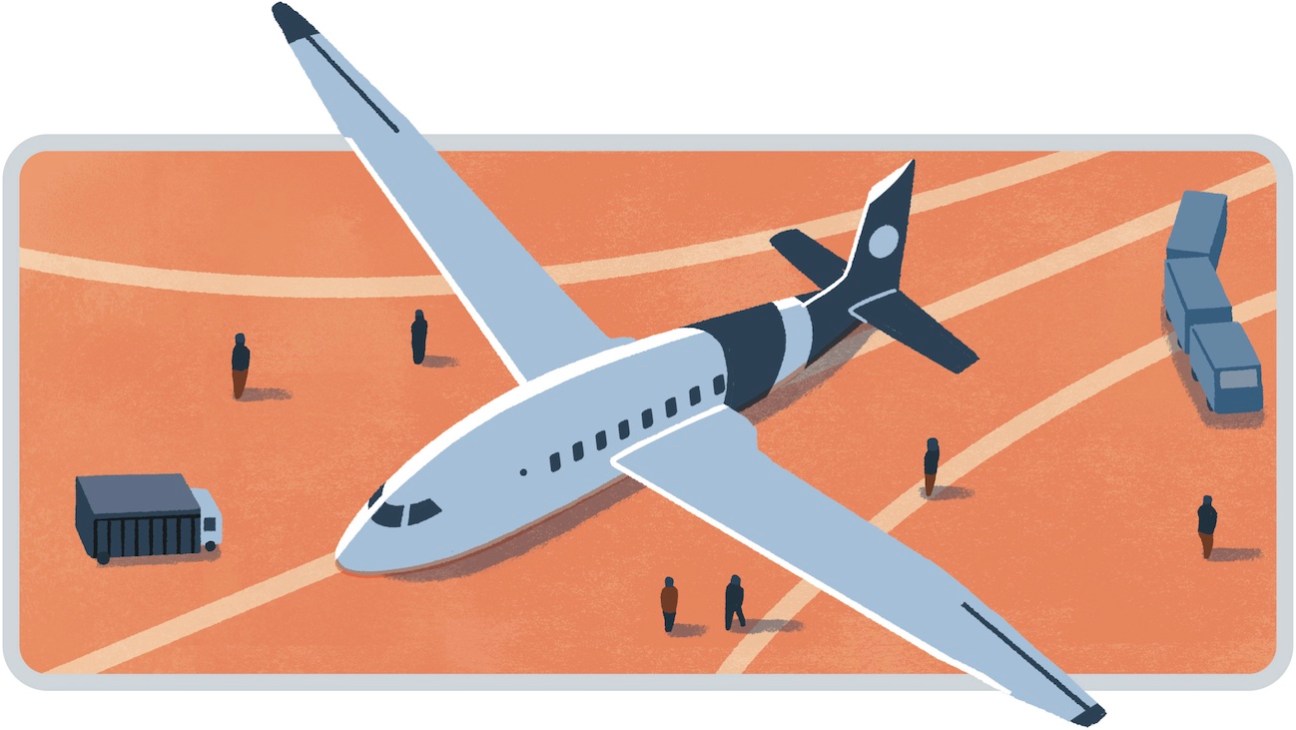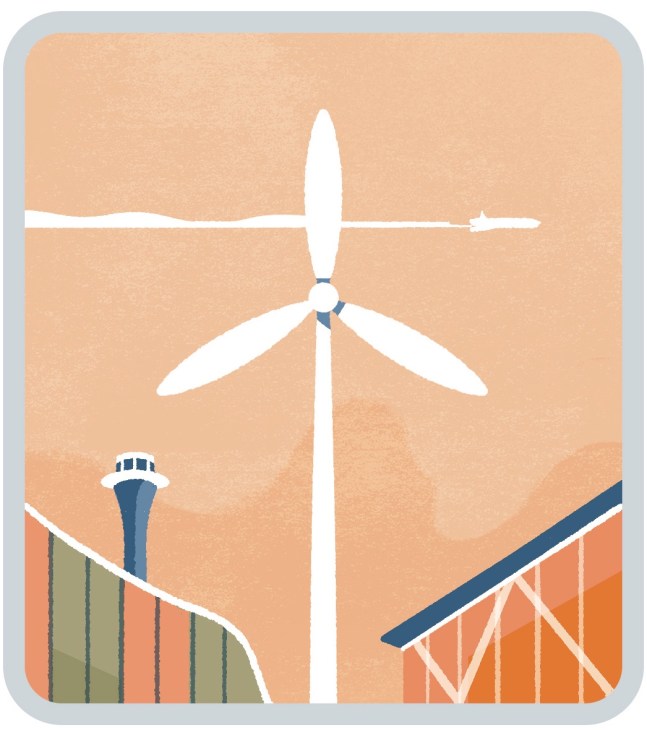What zero-emission flying really needs: smarter planes and radically different airports
Aviation's future won’t just be won in the sky - it starts with rethinking everything on the ground.
Imagine boarding your zero-carbon emissions commercial flight of the future. Is it a curvaceous wide-body jet powered by hydrogen fuel cells? A helicopter-like craft with several rotors fuelled by advanced batteries and piloted by a computer? An airship filled with gas, like it’s 1922 once again? It could be any or all of these. Or none. The truth is that very few people have truly grasped what emission-free flying might look like, let alone how to make it commercially viable enough for it to be an alternative to what we have now. What almost everyone agrees on, however, is that it’s vital to figure it out – and soon.
While there are all manner of promising developments and innovations in the sector, with hundreds of companies large and small working on answering this question, one sticky issue remains: the energy density of jet fuel – the amount of energy held in a given volume – is many times greater than just about everything else we can currently come up with. That is, at least among fuels we can hope to produce and deliver to aircraft, store and use safely. So far there have been lots of lofty promises but not much to show for them.

“It’s not around the corner,” says Henrik Littorin, programme manager at electric aviation development project Elis in the north of Sweden, when we ask about when zero-emissions commercial aircraft will be up and flying. “It’s obvious that the industry is struggling. Existing aviation systems and regulations were developed over many, many years and now you have to do that all over again. And you have to make sure that everything is super safe. That’s on top of the challenges of battery technology and sourcing clean energy. When you start developing something new, such as an electric aircraft, when you start to build and develop it, that’s when you really discover the challenges.”
Littorin says that there is still optimism in the industry but it comes with a sense that expectations will need to be managed. This means a revolution for the entire sector, from the aircraft themselves and the infrastructure to the politics and regulatory frameworks. Everything needs to change. That is disruptive, of course, but there are opportunities too. And for any of this to be viable in the kind of time frames being talked about, every stakeholder needs to be working in concert, pursuing the same goals with the kind of efficiency and co-ordination that is rare on the scale that is needed here.
Yet outfits such as Elis are not waiting for all of that to come together. It has partnered with manufacturer ZeroAvia, the airline Braathens, flight school Green Flight Academy and power company Skellefteå Kraft to launch a demonstrator project to not only fly an aircraft powered by hydrogen fuel cells but also showcase that this can be done within an entirely “green” ecosystem. This means producing so-called green hydrogen, transporting it to the airport and storing it, fuelling an aircraft and flying it to another airport and back. The idea is to show that it’s all possible, even if at a small scale for now.
If you want to look at just about every possible technology we might end up with, it makes sense to look at manufacturers such as Airbus, which has gone all in on figuring out the sustainable aircraft of the future. The company knows that this is an existential question, and with its size and resources it can afford to pursue a number of avenues at once, even if some end up as dead ends.

Until recently, the aviation industry has been on a steady path of incremental improvements in efficiency. Manufacturers point to the fact that since 1990, co2 emissions have been reduced by 50 per cent per passenger. This has been achieved by reducing aircraft weight, improving aerodynamics and boosting engine efficiency. However, because the number of flights has continued to grow, total emission figures remain high. “Today, these three parameters are not sufficient,” says Karim Mokaddem, vice-president Airbus Group Hybrid & Electric Strategy. “If we continue like this, we’re pretty sure we won’t reach the 2050 [net-zero] target.We need another parameter in the game – and that’s the fuel.”
Mokaddem explains that there are two ways to do this: either use electrons as the fuel, stored in batteries or hydrogen fuel cells, or use a different form of fuel, which right now means sustainable aviation fuel (SAF) made from non-petroleum feedstocks.
Batteries are comparatively simple, delivering electricity to engines. But they are heavy and their energy density is low. Hydrogen has a high energy density and zero emissions when used as a fuel but it comes with several complications. It can be very energy-intensive to produce and that production process can create emissions. Hydrogen could either be used directly as a fuel to run aircraft engines or in hydrogen fuel cells, which then produce electricity to run the motor.

“For the moment, we don’t know what will be a viable technology in terms of maturity and the ecosystem,” says Mokaddem. “There’s no silver bullet. Speaking as an engineer, what we have today are only problems. Nothing is really working. We have difficulty finding the right electric motor. There’s no battery that can fulfil what we need.” Increasingly, it looks like different technologies might suit different segments of aircraft, so it makes sense to work on multiple avenues to achieve emissions- free flight. For instance, the current battery technology can be used viably on aircraft that have up to nine seats. That’s not a lot of capacity so it ends up being mostly the domain of “urban air mobility” or evtol aircraft (electric vertical take-off and landing).
As a result, manufacturers are turning to hybrid aircraft models for the regional aircraft segment, which can carry 20-plus people. One example is Heart Aerospace, which is developing a 30-seater aircraft capable of flying 400km. Jet fuel-powered turbo generators charge the batteries that power the engines. It has purchase commitments from major airlines such as Air Canada and United, but for the moment, these commitments are mostly a matter of PR. Its first flight isn’t scheduled until 2026 and that date could well slip.
Some remain optimistic about putting an all-electric aircraft into service using existing technology. Cosmic Aerospace is working on the Skylark, a 24-seater electric plane that can fly 1,000km emissions-free thanks to an ultra- efficient wing, a lightweight structure and other refinements. The company hasn’t waited for a breakthrough in battery technology and says that it can have the plane in service for 2029. “Nothing has changed for us,” says its founder, Christopher Chahine, when asked whether the firm has faced setbacks. He believes that battery-powered aircraft have an advantage because of the inefficiencies and potential emissions of power sources.
“Full-system energy efficiency, from generation to usage, is crucial to ensure that the overall energy needs stay within reasonable limits,” he says. “Hydrogen and SAF generation requires many energy conversion steps, each introducing losses and additional costs. This all adds up to an inefficient use of energy overall. Battery-powered electric systems have a much higher energy efficiency, so there is less valuable energy lost between generation and usage. Energy needs directly translate to operating costs and ticket prices. If flying is to remain affordable and accessible for most people, efficient energy usage will be paramount for as long as clean energy isn’t abundantly available.”

The availability of clean energy is a critical point and is often left out of the discussion. Even once these aircraft are designed and proven to be airworthy and economical, one burning question is where all that clean energy to power them will be sourced. Elan Head, who covers the sector for industry news website The Air Current, points to a recent research paper, which estimated that 9 per cent of the world’s renewable electricity and 30 per cent of “sustainably available biomass” would be required for aviation to meet its net zero targets in 2050.
“Some have proposed that airports should be rethought to become energy farms,” says Head. “If you have an industry that requires massive amounts of renewable energy, then maybe the industry should be responsible for providing some of that energy.”
That leads to another intriguing question: what will the airport of the future look like? Large airports might find that they need to provide multiple fuel sources at the same time, including hydrogen in gas and liquid form, sustainable aviation fuels and megawatt chargers for battery-powered aircraft. How will all these fuels be efficiently delivered to the aircraft that need them? Where will they be generated and stored? The answers are unclear, but these questions will no doubt reshape how we think of building and running airports in the decades to come.

Then there are the wilder ideas for aircraft development. Magpie Aviation is working on a system for enabling longer-range, emissions- free flights without having to invent a more efficient fuel source. According to its vision, a hybrid electric aircraft takes off under its own power and then hooks up to a second or more aircraft with their batteries fully loaded, which tow the passenger aircraft towards its destination. This means that its range can be extended to well beyond 1,500km. The company says that it sees this as the only way to replace commercial flights without advances in technology that we have yet to make.
The general attitude in the industry seems to be that, for now, any and all ideas are welcome. “Working together is the way to get past this,” says Mokaddem. He explains that Airbus is pursuing every possible avenue to see what works, from large hydrogen- fuelled aircraft to small battery-powered demonstrators. And it’s doing this by working not only across the whole Airbus group but also with key players across all transportation industries, from French aerospace giant Safran to automobile company Renault. “For the first time we are not alone,” he says. “Today there are synergies across different transport industries. It took a century for the auto industry to enter into electric mobility. We are willing to do it in less than 20 years.” In the end, Henrik Littorin puts it best. For now, he says, “it’s just really important to get things up in the air”.
Half
Average reduction in co2 emissions per airline passenger since 1990, thanks to improvements in aerodynamics and fuel efficiency.
4.6bn
Annual passenger numbers before the coronavirus pandemic, nearly four times as many as the 1.2 billion in 1990, according to the International Energy Agency.
400km
Maximum predicted range of Heart Aerospace’s electric-hybrid 30-seater plane by its launch in 2026.
9 per cent
Proportion of world’s sustainable energy required by aviation to meet net-zero emissions by 2050.
A third
Approximate amount of the world’s sustainably available biomass that would be needed to power aviation if net-zero is to be reached by 2050.
About the writer:
Stockholm-based Leigh is Monocle’s transport correspondent.
Illustrations by Yo Hosoyamada


